Outdoor play is essential for preschool kids. It helps them develop physically, mentally, and socially while having fun in nature. Engaging in various outdoor activities can improve motor skills, creativity, and emotional well-being.

Preschool Kids
Preschoolers thrive when they can explore their environment. Activities like running, jumping, and interacting with nature enhance their physical abilities and spark their imagination. From simple games to more structured sports, outdoor play offers endless opportunities for learning and growth.
Embracing outdoor activities also encourages a healthy lifestyle from a young age. Getting outside fosters curiosity and teamwork, making it an important part of childhood development.
Key Takeaways
- Outdoor play supports physical and social development in preschoolers.
- Engaging activities inspire creativity and exploration.
- Safe outdoor environments promote healthier, active lifestyles.
Benefits of Outdoor Play for Preschoolers
Outdoor play offers many advantages for preschoolers. It promotes physical health by encouraging children to be active. Activities like running, jumping, and climbing build strength and endurance.
Playing outside also supports mental development. Children engage in imaginative play, which fosters creativity. They learn to create their own games and stories.
Social skills improve through outdoor play. When preschoolers play together, they learn to share and cooperate. These interactions help them build friendships and understand teamwork.
Moreover, spending time outdoors can enhance focus. Exposure to nature has been linked to improved attention spans. For preschoolers, this can lead to better learning experiences later on.
Research has shown that outdoor play can reduce the risk of nearsightedness. Time spent outside helps children’s eyesight by allowing their eyes to focus on distant objects. This simple habit contributes to their long-term vision health.
Outdoor activities provide opportunities for children to connect with nature. They can explore their surroundings, observe wildlife, and learn about plants. This connection can foster a sense of responsibility for the environment.
In summary, outdoor play is crucial for preschool development. It supports physical, mental, and social growth, making it an essential part of a child’s daily routine. Encouraging outdoor play is beneficial for every preschooler.
Essential Safety Considerations

Preschool Kids
When engaging preschool kids in outdoor play, safety is a top priority. This section covers crucial aspects such as supervision, age-appropriate activities, weather considerations, and playground safety to ensure a secure and enjoyable experience for young children.
Supervision and Buddy Systems
Active supervision is vital for keeping preschool children safe during outdoor play. Caregivers should maintain a close watch, ensuring they can always see and hear the children.
Buddy systems are also effective. Pairing children encourages them to look out for one another. With a 1:4 staff-child ratio, adults can manage and monitor groups better. Regularly visiting and checking on each child can prevent accidents and ensure that children explore safely.
Age-Appropriate Activities
Selecting activities suited to children’s ages and development levels is important. Games should match their physical abilities and understanding. For instance, toddlers might enjoy simple ball games or sandbox play, while preschoolers could take on obstacle courses or climbing activities.
Consider incorporating these ideas:
- Toddlers: Short runs, simple hide and seek, and sensory play.
- Preschoolers: Group games, sports, and nature walks.
These selections promote safe exploration while fostering physical skills without overwhelming them.
Weather and Clothing
Weather conditions significantly affect outdoor play safety. Children should be dressed appropriately for the temperatures. In cold weather, layering clothing can help keep them warm. In hot weather, light, breathable fabrics protect against overheating.
Sun safety is crucial too. Using sunscreen and providing hats can shield delicate skin. When it’s rainy, ensure children wear appropriate rain gear to stay dry.
Always check the weather forecast to decide whether it’s safe to play outside.
Playground Safety
Playgrounds require attention to safety features. Equipment should be age-appropriate and in good condition. Regularly inspect swings, slides, and climbing structures for hazards.
Parents and caregivers should teach children proper playground etiquette, including waiting their turn and using equipment correctly.
Safety checks before play will help:
- Ensure fall surfaces are adequate.
- Confirm no sharp edges or unsafe equipment.
- Maintain a clean and clear play area.
Following these guidelines will promote safer experiences for preschool children during outdoor play.
Creative Play and Learning
Engaging preschoolers in creative play fosters their imagination and supports learning. This section focuses on hands-on activities that combine art, nature, and imaginative exploration.
Nature Art Projects
Nature art projects allow children to explore their surroundings while creating. Kids can gather leaves, rocks, and flowers to use in their artwork. For example, they can make leaf rubbings by placing a leaf under the paper and rubbing it with a crayon.
Another fun activity is creating flower crowns. Children can use flexible branches or twigs to form a circle, and then thread flowers and leaves through. This not only encourages artistic expression but also teaches them about the different plants in their environment.
Parents can guide them by discussing colours and shapes found in nature. This conversation enhances vocabulary and understanding of the world around them.
Gardening for Kids
Gardening is a fantastic way to introduce kids to nature while teaching responsibility and patience. Children can start a small garden with easy-to-grow seeds like radishes or sunflowers.
They will learn about plant growth as they water and care for their garden. This hands-on activity can also be tied to lessons on healthy eating. Kids can discuss where their food comes from and why it’s essential to eat fruits and vegetables.
Using tools like small spades and watering cans helps develop fine motor skills. Each season presents new learning opportunities, as children can plant in spring, tend in summer, and harvest in fall.
Imaginative Play Spaces
Creating imaginative play spaces encourages preschoolers to use their creativity. A simple cardboard box can transform into a spaceship or a castle. Decorating these spaces with crafts like painted rocks or drawn signs enhances the experience.
Parents can create themed areas in the backyard, like a pirate ship with ropes and flags or a jungle gym with hanging vines. Providing costumes adds to the fun, allowing kids to dress as characters from their imagination.
Imaginative play fosters social skills as children role-play and cooperate with peers. It also stimulates cognitive development as they create stories and scenarios. Simple props can enrich their play and inspire deeper engagement.
Physical Activities and Sports
Engaging preschoolers in physical activities and sports is vital for their development. These activities help improve motor skills, coordination, and social interaction. Creating exciting experiences can keep children active and foster a love for movement.
Obstacle Courses and Races
Obstacle courses are excellent for encouraging movement and agility. They can be set up in the backyard or at local parks using items like cones, hula hoops, and balance beams.
Children can practice crawling under tables, hopping over ropes, or running around cushions. Parents can turn this into a race by timing each participant. Competition can be fun and motivate kids to challenge themselves.
Adding themes, like a jungle or pirate adventure, can make the course more engaging. Parents can encourage teamwork by having kids work together to complete tasks.
Ball Games and Team Sports
Ball games are a great way to introduce preschoolers to teamwork and coordination. Simple activities like kicking a soccer ball or tossing a beach ball can enhance hand-eye coordination and promote physical fitness.
Parents can organize small games with rules that are easy to understand. For example, setting up a mini soccer game where children learn to score and defend can be fun.
Using soft, lightweight balls ensures safety while playing. Adding some elements like friendly competition can motivate kids to participate actively. It’s important to focus on fun rather than competition at this age.
Basic Gymnastics and Movement
Introducing basic gymnastics helps preschoolers build strength and flexibility. Simple movements such as somersaults, handstands, or rolling can be practised in a safe space, like a soft mat or grass.
Classes are also an option. Experienced instructors can teach children how to execute techniques safely. Basics like balance on one foot, jumping, and landing properly are crucial skills to develop.
Parents can encourage movement through games that involve stretching and bending. Obstacle courses can incorporate gymnastic elements, making playtime both fun and educational.
Water Play and Aquatic Activities
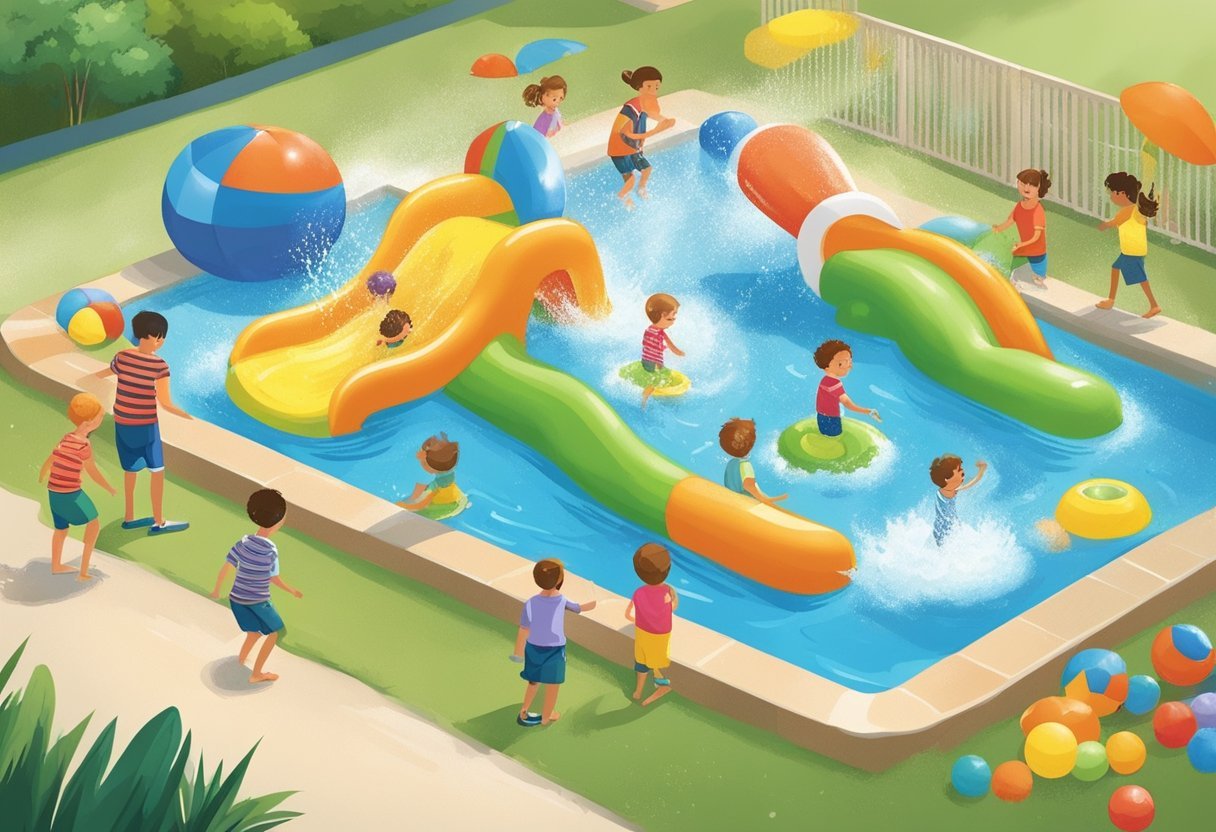
Preschool Kids
Water play offers preschoolers a fun way to cool off and learn through a variety of exciting activities. These activities not only enhance motor skills but also provide opportunities for creative play and exploration.
Sprinkler Fun
Sprinklers can transform any backyard into a water wonderland. Preschoolers can run, jump, and dance through the spray, adding excitement to a hot day. Parents can set up a simple sprinkler in the yard, allowing kids to run freely.
For safety, it’s important to make sure the area is clear of obstacles. Kids can take turns doing various activities like racing to the sprinkler or playing tag while staying wet. Using colourful hula hoops can also create fun zones for kids to jump through as they dash through the water.
Pool Games
If there is access to a pool, many games can keep preschoolers entertained and active. Simple activities like pool noodle races are great for developing swimming skills. Children can balance on noodles while trying to paddle across the pool.
Water balloon toss is another exciting game. Kids can stand a few feet apart and gently toss water balloons back and forth, increasing the distance as their skills improve. These activities help improve hand-eye coordination while ensuring everyone has a splash of fun.
Water Table Play
Water tables are excellent for sensory exploration. They can be filled with water, and kids can use cups, funnels, and small toys. This allows for creative play and helps develop fine motor skills.
Adding different items like rubber ducks or sponge shapes can make the experience even more engaging. Children can experiment by guessing which items will float or sink. This type of play encourages curiosity and basic science concepts while promoting social interaction as kids share and play together.
Exploration and Adventure
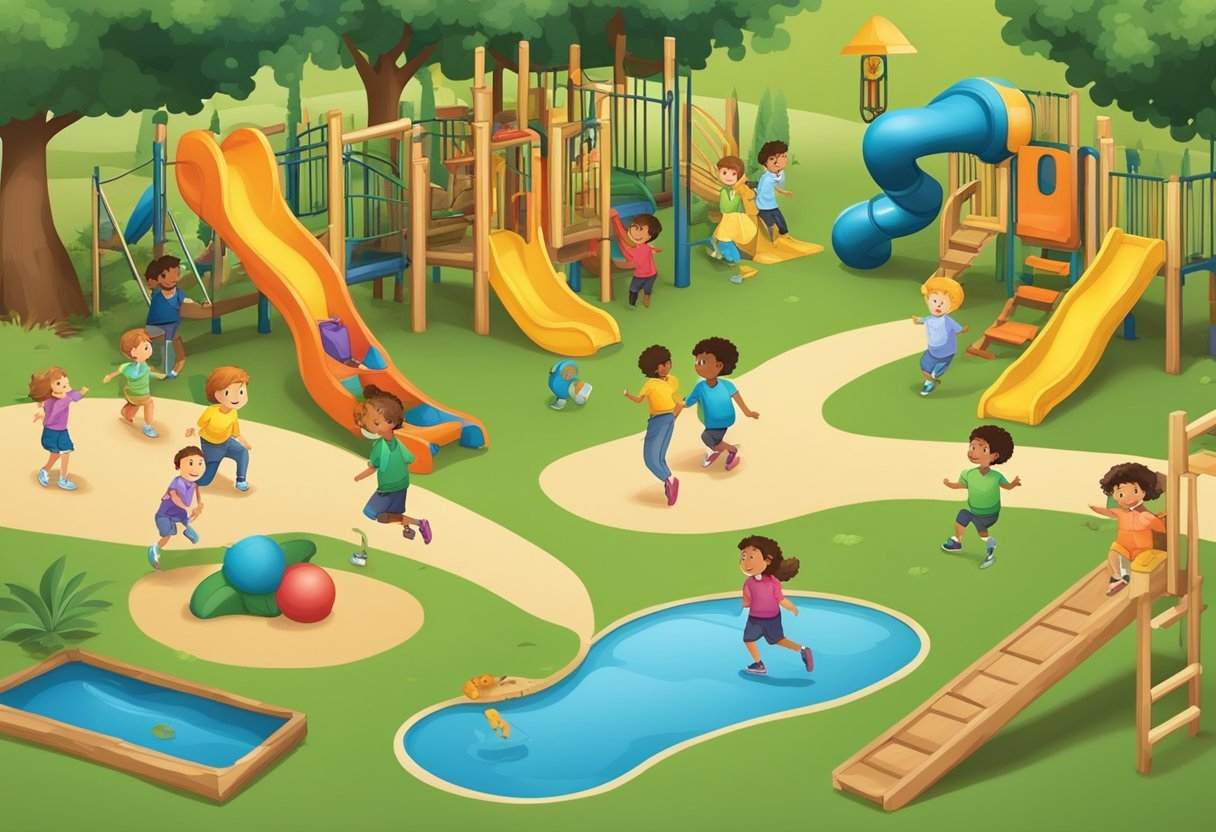
Preschool Kids
Engaging preschoolers in exploration and adventure fosters curiosity and encourages a love for the outdoors. Activities like scavenger hunts, nature walks, and outdoor exploration kits bring children closer to nature and promote physical activity.
Scavenger Hunts
Scavenger hunts are fun and interactive ways for children to explore their surroundings. They can be tailored to different environments, whether in the backyard, park, or nature trail.
Parents can create a list of items for kids to find, such as specific leaves, flowers, or rocks. This not only makes the activity exciting but also helps children learn to observe details in nature.
To add a twist, introduce themes, like colours or shapes. Afterwards, children can share their findings, enhancing social interaction and communication skills.
Nature Walks and Hiking
Nature walks provide opportunities for preschoolers to connect with their environment. These walks can be short, manageable hikes suitable for young children.
As they walk, parents can encourage kids to notice different sounds, plants, and animals. Asking questions like, “What colour is that flower?” or “What sounds do you hear?” promotes engagement and learning.
Parents need to prioritize safety by choosing well-marked trails and ensuring kids wear suitable shoes. Observing wildlife during these walks can also spark interest in biology and ecology.
Outdoor Exploration Kits
Outdoor exploration kits are excellent tools for enhancing learning and discovery. These kits can include items like magnifying glasses, binoculars, and collection containers.
When preschoolers use these tools, they can closely examine insects, plants, and other natural elements. For example, a magnifying glass can make examining leaves and bugs fascinating.
Parents can also involve children in creating their kits, allowing them to select their favourite items. This involvement makes the exploration more personal and exciting, encouraging a deeper connection to nature.
Music and Performing Arts Outdoors
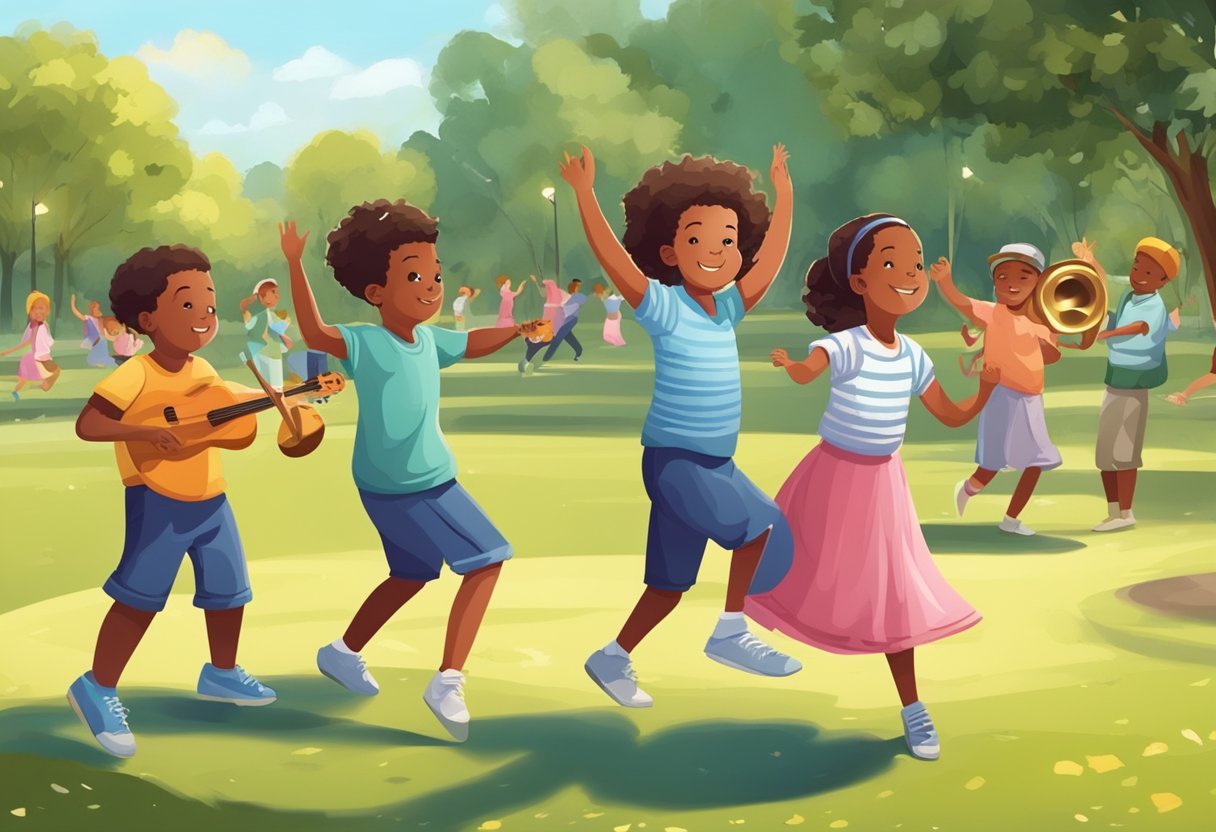
Preschool Kids
Engaging preschool kids in music and performing arts outdoors can enhance their creativity and physical activity. Activities like sing-alongs, dance, and puppet shows create joyful learning experiences.
Outdoor Sing-Alongs
Outdoor sing-alongs provide a fun way for preschoolers to explore music while enjoying nature. Teachers or parents can lead familiar songs, making the experience interactive by encouraging children to join in with actions or instruments.
Suggested songs include:
- “The Wheels on the Bus”
- “Twinkle, Twinkle, Little Star”
- “If You’re Happy and You Know It”
Using simple instruments, like shakers or tambourines, adds excitement. Singing outside also helps improve listening skills, as kids must pay attention to the music around them and their peers.
Dance and Movement
Dance and movement activities promote both physical fitness and self-expression. Preschoolers can participate in games like “Musical Statues” or follow along with guided dance routines.
Incorporating props, such as scarves or ribbons, can make movements more engaging. Children can throw scarves in the air while dancing to music, enhancing their coordination and rhythm.
Creating a free dance session allows children to express their creativity. Parents can encourage participants to dance freely while recognizing everyone’s unique moves. This supports confidence and joy in self-expression.
Puppet Shows and Storytelling
Puppet shows and storytelling engage children’s imaginations while allowing them to act out stories. Using simple puppets made from socks or paper bags can be a fun activity for everyone involved.
Children can create their puppet characters and perform short skits based on familiar tales. This encourages teamwork and communication. When telling stories, parents should encourage preschoolers to use their voices and gestures, making the experience dynamic.
Setting up a small outdoor stage or performance area helps create a sense of occasion. This stimulates creative thinking and makes storytelling an interactive and enjoyable learning experience for young learners.
Building and Construction Play
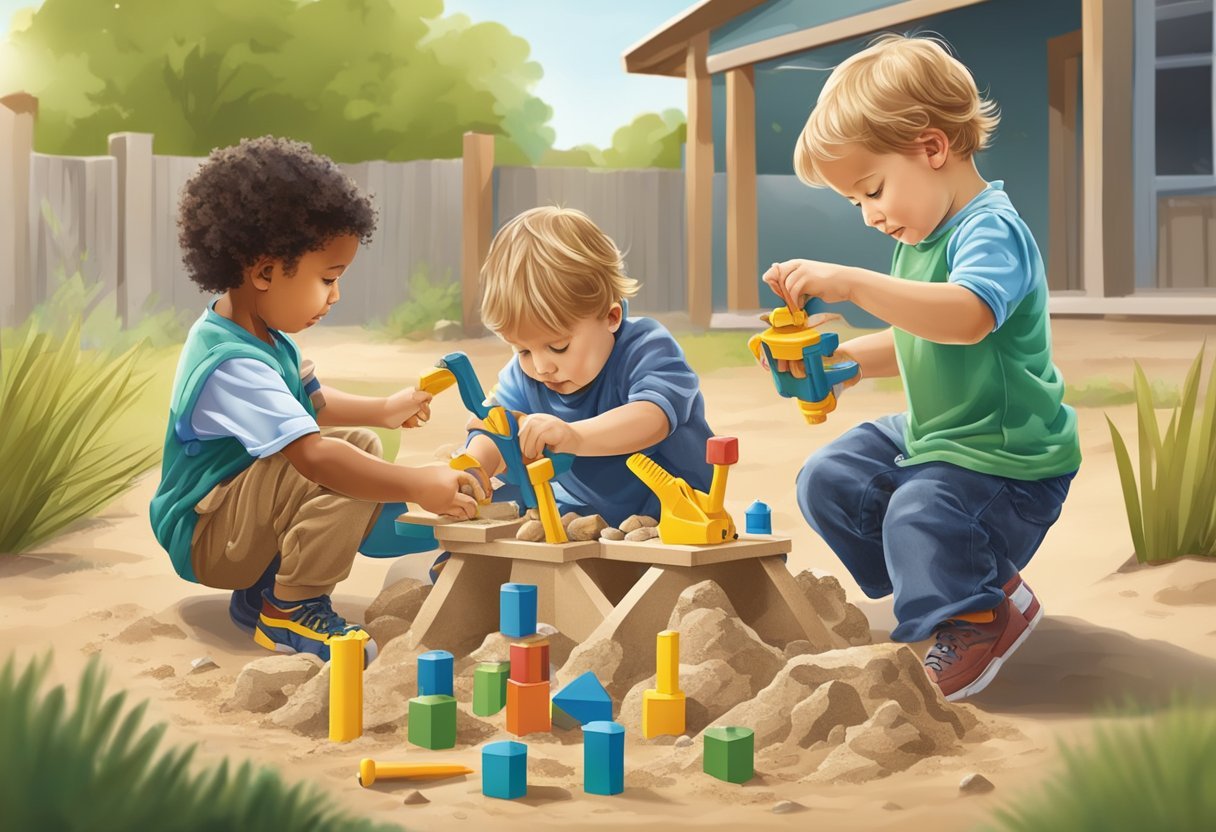
Preschool Kids
Building and construction play encourages creativity and develops important skills in preschool children. This active form of play allows kids to engage with materials and their surroundings while honing fine motor skills and problem-solving abilities.
Sandcastle Constructions
Sandcastle construction is a fun outdoor activity that sparks the imagination. Children can use buckets, shovels, and molds to create various sand structures. This activity develops hand-eye coordination as they learn to pack sand tightly and shape their creations.
To enhance the experience, add water to make the sand easier to mould. Kids can also incorporate natural materials like sticks and shells for decoration. Discussing their designs helps improve communication skills and encourages teamwork when building together.
Safety is key, so ensure the sand is clean and the building area is free from debris. This play activity is not only enjoyable but also educational, as children explore concepts like balance and symmetry with every sandcastle.
Outdoor Building Blocks
Outdoor building blocks provide endless fun and learning opportunities. These blocks come in various sizes and materials, allowing children to construct anything from simple towers to intricate designs. While playing, children engage their imaginations and practice spatial awareness.
Using large, lightweight blocks aids physical development, as kids learn to lift, stack, and balance objects. Encourage them to collaborate on projects, supporting social skills and teamwork. Set challenges, like building the tallest structure or creating a specific shape, to stimulate problem-solving.
To maximize safety, choose blocks made from non-toxic materials. This playful activity gives kids a chance to explore engineering principles while enhancing their dexterity and confidence.
DIY Forts and Play Structures
Creating DIY forts and play structures is an exciting way for kids to engage in imaginative play. Using simple materials like blankets, chairs, and cardboard boxes, children can build their own hideaways. This not only stimulates creativity but also fosters critical thinking as they figure out how to support their structures.
Kids love to personalize their forts, making the space feel uniquely theirs. They can add pillows for comfort or decorate with lights for an inviting atmosphere. Encouraging them to create themed forts, like a pirate ship or castle, promotes storytelling and role play.
Safety is important, so supervise the building process and ensure stability. This activity invites collaboration and communication, enhancing social skills while providing hours of entertainment.
Relaxation and Quiet Time Outdoor Activities
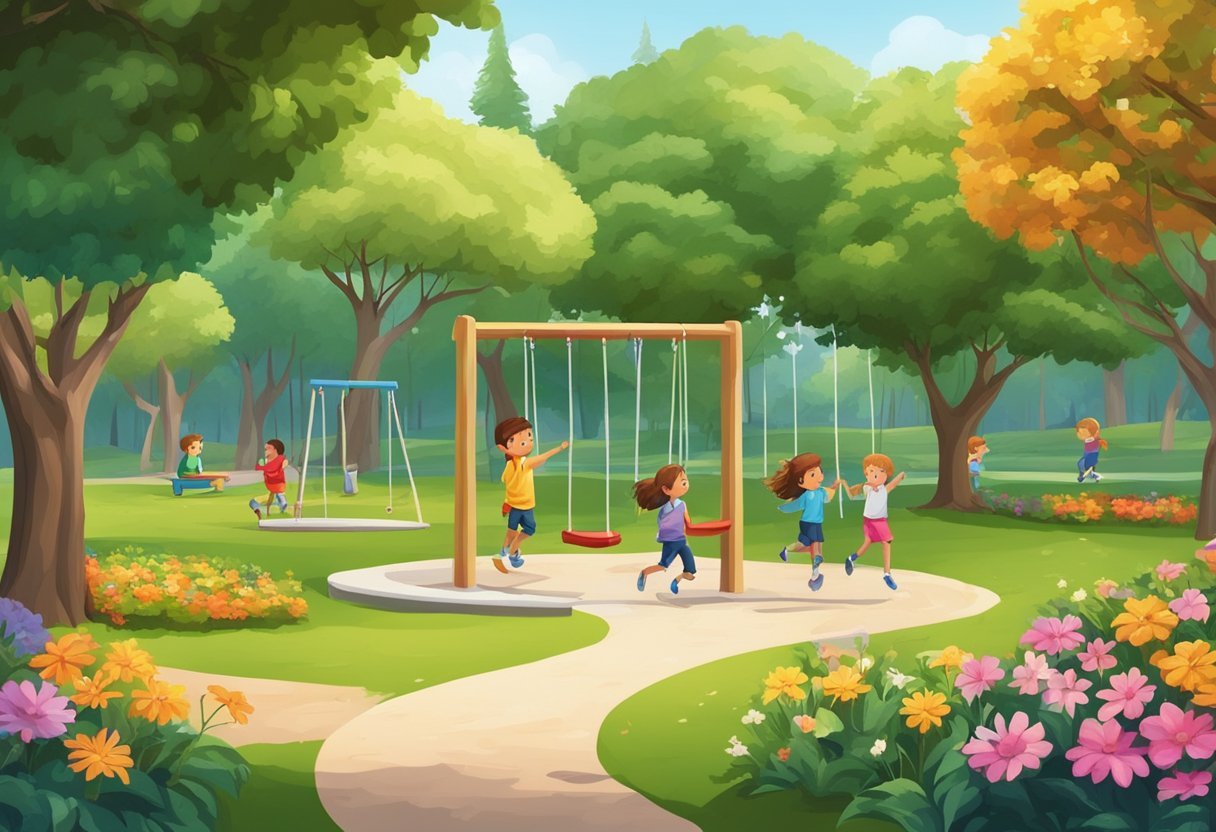
Preschool Kids
Outdoor play can also include relaxation activities that help preschoolers unwind. These activities promote calmness and encourage kids to connect with nature while enjoying quiet moments.
Outdoor Reading Nooks
Creating a cosy reading nook outside can encourage a love for books. Find a shaded area under a tree or set up a small tent with cushions. Bring along a selection of age-appropriate books.
Parents can help their kids choose stories that spark their imagination. Encourage children to whisper their favourite parts or even act them out. Reading outdoors allows kids to enjoy fresh air while focusing on captivating stories. This connection with nature can enhance their overall reading experience.
Nature Meditation for Kids
Nature meditation can help preschoolers find peace and focus. Find a quiet space in the yard or park with trees, flowers, or a gentle stream.
Start the session by sitting together on the grass. Use simple breathing exercises to guide them. For example, encourage them to breathe in deeply through their nose and out through their mouth.
After a few minutes, ask them to listen to the sounds around them, like rustling leaves or chirping birds. This practice can foster mindfulness and teach kids the importance of slowing down.
Picnics and Cloud Watching
Picnics offer a perfect chance to enjoy food and the outdoors. Parents can pack snacks and a blanket to sit on while soaking in the surroundings.
During the picnic, take time to lie back and watch the clouds. Encourage kids to spot different shapes and animals in the clouds. This activity encourages creativity and imagination.
Additionally, discussing what they see can boost communication skills. A picnic combined with cloudwatching creates a relaxing atmosphere that allows preschoolers to connect with nature and each other.
Frequently Asked Questions

Preschool Kids
Outdoor play is essential for preschoolers as it supports their physical, social, and emotional development. Here are some common questions regarding activities and benefits related to outdoor play for young children.
What are some simple outdoor play activities suitable for preschoolers?
Preschoolers can enjoy a variety of simple outdoor activities. Playing with a ball, building sandcastles, and nature scavenger hunts are effective ways to engage them. They can also play tag or hopscotch, which helps develop coordination and stamina.
How can free outdoor play benefit preschoolers’ development?
Free outdoor play offers numerous developmental benefits. It encourages creativity as children invent their games. Additionally, it promotes physical fitness, builds social skills, and enhances problem-solving abilities as they navigate their environment and interact with peers.
What are the best outdoor physical activities for 3-5-year-olds?
Activities such as running, jumping, and climbing are great for preschoolers. Setting up obstacle courses can challenge their motor skills. Riding tricycles or balance bikes also improves coordination and balance, making it enjoyable and beneficial for their physical growth.
How can one encourage preschoolers to engage more in active outdoor play at home?
To encourage outdoor play, caregivers should create inviting play spaces with various equipment, such as swings or slides. Setting aside specific times for outdoor activities can help establish routines. Joining in the play and showing enthusiasm also motivates children to participate more actively.
In what ways do preschoolers develop through active outdoor play?
Active outdoor play supports multiple areas of development. It enhances physical skills, including strength and coordination. Socially, children learn to cooperate and communicate with others, while emotionally, they gain confidence and learn to manage their feelings during play.
What strategies can childcare providers use to engage children in outdoor play activities?
Childcare providers can incorporate structured games that promote teamwork and cooperation. They can also offer diverse play equipment that caters to various interests. Regularly changing the outdoor environment and introducing new activities keeps the experience fresh and exciting for the children.
Read More About – Finding the right books for preschoolers




Leave a Comment